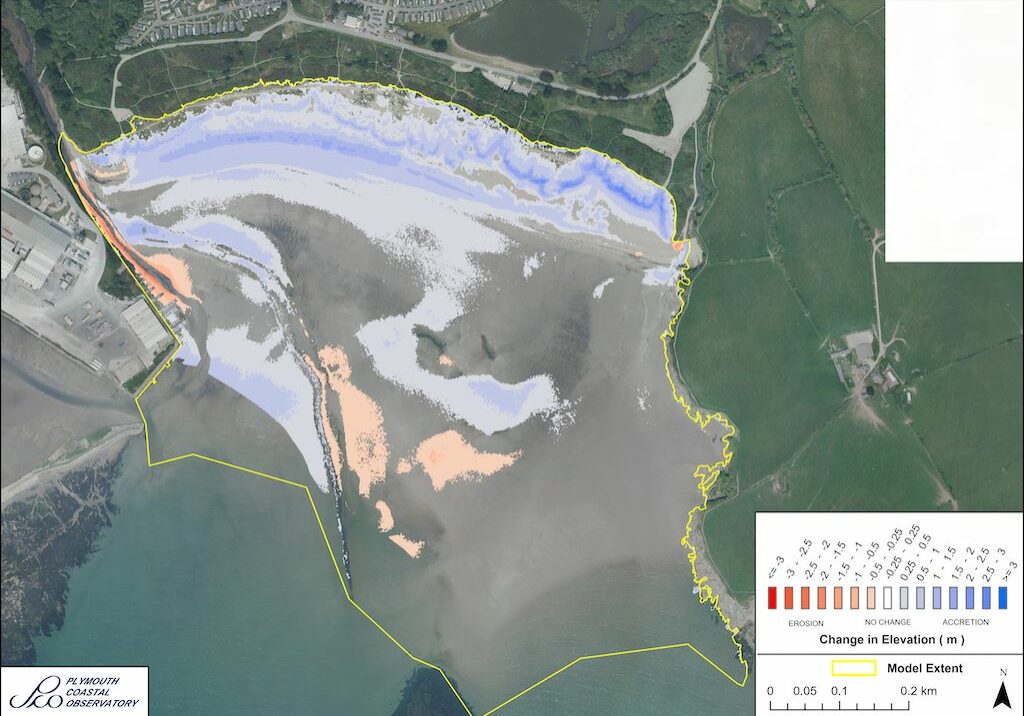
Par Sands (Cornish: Porth, meaning ‘landing place or cove’) is a wide south facing beach, within St Austell Bay, located on the south coast of Cornwall.
Two watercourses flow onto the beach, to the east runs the Polmear Stream and to the west the Par River. The eastern boundary of Par Sands is defined by the short headland of Booly Beach, which at low water can provide access to the harbour of Polkerris. To the west of Par Sands the boundary is more artificially defined by the quayside of Par Docks.
Par Sands has undergone significant change over a relatively short period of time. In the late 19th century, the beach extended up to the Newquay Branch line, now the haulage road for the Docks. Sand has accumulated on the site south of this, upon which some areas are used for parking, to accommodate visitors to the site, and also used as a holiday park. This accumulation of sand means that some communities, once closer to the shore, are now slightly more distant. This is evident in place names like Tywardreath, Cornish for ‘House on the Strand’, a village now considered more removed from the coastline.


Coastal Change
The coastline of Cornwall is an ever-changing environment. It is energetic, dynamic, never still and changes with each wave and each tidal cycle. Some of the changes we see are gradual and barely noticeable, whilst others, such as rockfalls, happen suddenly and often shockingly.
From one visit to the next it can sometimes be difficult to see how a beach and dune system has changed, but information has been collected, and is being collected through the Making Space for Sand project, to help us better understand how the coastline is changing. The purpose of this section of the website is to understand each location has changed over time, how it could change in the future and understand the policies that influence how we can respond to these changes.
Shoreline Management Plans (SMP)
The Shoreline Management Plan (SMP) is a strategic planning and management assessment tool that helps identify and measure the risk associated coastal erosion and coastal flooding. The document makes a number of policy recommendations over short, medium and long term timeframes setting out a strategic approach to managing the built, natural and historic environments associated with the coastline. Within SMP there are four policy approaches which have been assigned to stretches of coastlines. The four policies are: No Active Intervention (NAI), Hold the Line (HTL), Managed realignment (MR), and Advance the line (ATL).
Par Sands sits within Policy Development Zone 3 (PDZ3), in Management Area 6 (MA6), within Policy Units (PU) 6.1, 6.3 and 6.4. The policy recommendations for these policy units are detailed in the table below and the SMP can be accessed through the Cornwall Council website.
Use your touchscreen
to scroll the below table
| Policy Unit | Policy Plan | ||||
| 2025 | 2055 | 2105 | Comment | ||
| 6.1 | Undefended cliffs
Main Policy Sub Policy
|
NAI DnD |
NAI DnD |
NAI DnD |
Continuation of existing policy from SMP1. Meets objectives relating to the AONB and Heritage coast designations. Allow natural coastal evolution to occur to support conservation interest of protected sites.
|
| 6.3 | Par Sands
Main Policy Sub Policy |
NAI LAO |
MR LAO |
MR NF |
Encourage a naturally functioning shoreline, with local activity restricted to dune management, with potential to allow roll back of the dunes dependent upon investigations into contamination risk from landfill. Designation as a ‘Coastal Change Management Area’ within the land use planning system may be necessary. The implications of this management approach for highway links along this section will also need to be considered.
|
| 6.4 | Par Docks
Main Policy Sub Policy |
MR LAO |
NAI LAO |
NAI LAO |
Retain the strategic importance of Par Docks to support sustainable regeneration of local area. Some realignment to allow for sea level rise and to improve longer term sustainability should be considered in line with Par Sands, with the aim for only limited local works into the future and a move toward a non-interventional frontage.
|
| Key Main Policy: HTL - Hold the Line, A - Advance the Line, NAI – No Active Intervention MR – Managed Realignment
Sub Policy: DnD – Do not Defend, LAO – Local Activity Only, NF – Natural Features |
|||||


National Coastal Erosion Risk Mapping (NCERM)
National Coastal Erosion Risk Mapping (NCERM) provides a baseline of coastal erosion, for the coastline of England, over short, medium and long-term timeframes. The data is based on the natural and defence characteristics of the coastline and provides rates of erosion at differing levels of confidence to help better plan for worse case scenarios. The data provided is for guidance and does not estimate the absolute location of the future coastline.
The basic NCERM lines show erosion estimates for the Short Term (ST-20 years), Medium Term (MT-50 years) and Long Term (LT- 100 years). The data is further categorised by probability: 05 is 5% probability (a 1 in 20 chance of being exceeded) Red Shading, 50 is 50% probability of being exceeded (a 1 in 2 chance of being either exceeded or not exceeded) Orange Shading and 95 is 95% probability (a 19 in 20 chance of being exceeded) Yellow Shading. Click the link below to access the Cornwall Council NCERM Mapping site read the about section then click on layers.
Historical Images of Par Sands
Historical photographs provide a powerful insight into how the Cornish coastline has changed within the past Century. The Making Space for Sand project are working in collaboration with the Francis Frith collection and have been given permission to share historical images on a number of beaches considered within the project.
In looking back, we can better understand how the coastline has changed, helping us understand not only how the coastal fringe has developed but also the potential future changes that we my observe. When this is considered alongside forecasts of coastal erosion and sea level rise it will help enable us to better adapt to our changing coastline.
Par Sands from the eastern cliffs in 1938 (Image courtesy of the Francis Frith collection) and in 2024
Par Sands from the eastern cliffs, c1960 (Image courtesy of the Francis Frith collection) and in 2024

Modelling Coastal Change

Using data that has already been collected, combined with data collected through the Making Space for Sand project, a series of models will be carried out at each location. This will help us better understand how each location may respond to sea level rise and gain a deeper understanding of how coastal sediments move and behave.
The complexity of the modelling, and the data collection that helps inform it, means that modelling outputs will not be the same on all sites. Some locations will be more thoroughly investigated to understand more complex issues and provide data that can be more widely applied to other sites with similar characteristics.
As the project develops this section of the website will expand, sharing new reports and coastal change projections when they are produced.
LiDAR surveys, which are explained on the Data Modelling page, have been carried out by the South West Coastal Monitoring program at this location. The image shared here visualises where sand has eroded (areas shaded in red) and where it has built up (areas shaded in blue), between the LiDAR surveys carried out in 2008 and 2020. The darker the shade of red or blue the greater the amount of sand erosion or accumulation has been observed. The image helps visualise that beaches are areas that change shape over time and will continue to do so as sea levels rise.



Beach and Dune Ecology
Beaches and dunes represent an important transition between the marine environment and the terrestrial environment. This transition creates a range of special habitats and exposes a range of interesting features, which that can result in these spaces being highly designated and protected. The Making Space for Sand project will survey a number of dune systems. These surveys will help highlight how they may be changing, will identify rare species, will map invasive species, help us understand overall dune condition and identify potential constraints to improving their condition.
There are a range of designations that recognise a variety of different features. There are also a number of dunes systems where data has been collected to understand their habitat value. These are explored, on a site-by-site basis, in the section below.

Designations
Special Protected Area (SPA)
A Special Protection Area (SPA) are areas of international importance for the breeding, feeding, wintering and migration of rare, threatened or vulnerable bird species.
The Falmouth Bay to St Austell Bay SPA covers the area of 258,98 hectares, below mean high water (MHW),between Nare Point and Gribben Head. The area qualifies for designation as it is regularly used by Annex I listed species including the Black-throated diver, the Great northern diver and the Slavonian grebe.
Designated Cornwall National Landscape Area
From November 2023, all areas previously know as Areas of Outstanding Natural Beauty, or AONBs, were re-named National Landscape and in Cornwall became Cornwall National Landscape. However, the Management Plan still references the term AONB as this was formally adopted by Cornwall Council and cannot be amended until the next plan is produced.
Cornwall National Landscape areas are protected and have distinctive character and natural beauty are so outstanding that its in the nation’s interest to safeguard them. As such they have been nationally designated by the same legislation as National Parks and have the same status and level of protection.
The South Coast Eastern section of Cornwall National Landscape
The South Coast Eastern section covers an area of 4,630 hectares, which is 4.8% of the total Cornwall National Landscape area. The key landscape characteristics of this section can be split into two distinct areas: Fowey Ria and Polperro Coast. The approach to this section sees a marked change in character from that of the industrial, China clay related landscape of Par Docks and the busy nature of the holiday park at Par Sands in the setting of the area.
Image of the Time and Tide bell on Par Sands (Courtesy of the Friends of Par Beach)

Beach Dune Management Plan
Many of the sand dunes and beaches around Cornwall’s coast are experiencing erosion and sediment loss. This is due, in part, to lack of new sediment input to the shoreline system and rising sea levels. This is a pressing concern as these environments provide protection against the risk of coastal flooding, provide important habitats that cannot be easily recreated elsewhere if lost and help support the regions thriving tourism industry. It is therefore vital that the sand dunes and beaches around Cornwall’s coast are managed in a more sustainable way that balances the combined functions of beach-dune system.
In 2016, Cornwall Council produced Beach Dune Management Plans (BDMP’s) for 10 locations in Cornwall, including one at this location. The aim of the BDMP’s was to:
- Identify the best day-to-day management approach in terms of monitoring and intervention for the beach and dune system.
- Provide a longer-term approach to beach and dune management based upon an up-to-date understanding of coastal processes at the site, as well as predictions of future coastal evolution.
Where possible, the Making Space for Sand project will use these BDMP’s, supported by the data it collects, to work with landowners and environmental groups to help build more resilient and more biodiverse beaches and dunes that will help protect people and place from coastal erosion.
Sign up to Making Space for Sand
If you would like to get involved in helping to make dunes more resilient and biodiverse, want to help develop coastal adaptation and emergency plans or just want to know more about what the project is learning about coastal change, please click here:






